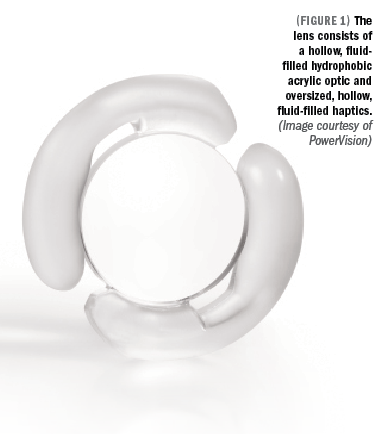Article
Fluid-based injectable IOL maintains stability in capsular bag
A fluid-filled, injectable accommodating IOL demonstrated accommodative and refractive stability in a recent 6-month prospective study.
Take-home:
A fluid-filled, injectable accommodating IOL demonstrated accommodative and refractive stability in a recent 6-month prospective study.
By Nancy Groves; Reviewed by Louis D. “Skip” Nichamin, MD

Dr. NichaminBrookville, PA-The refractive stability of intracapsular implantation of a fluid-filled accommodating IOL (FluidVision, PowerVision) was demonstrated from 1 to 6 months in a small, prospective study.
More in this issue: New double C-loop haptics improve stability for novel trifocal IOL technology
These findings confirm the results of a prior 1-year study of a non-injectable version of the lens, said Louis D. “Skip” Nichamin, MD, in private practice, Brookville, PA.

The study also demonstrated accommodative stability. There was no change in either defocus range or pharmacologically induced accommodation range of accommodation, he said.
Performance stability
According to Dr. Nichamin, it has been questioned whether a lens inside the intracapsular bag would cause the capsule to become fibrotic and thereby inhibit accommodative function. The 30-patient, prospective, single-arm study was designed to assess the performance stability of the lens.
In case you missed it: Low use of herpes zoster vaccine raises concerns
“At least over this time frame, there does not appear to be any degradation of the lens’ function,” Dr. Nichamin said. “In fact, the capsule stays quite clear, and the lens is performing slightly better over time rather than losing its initial function. The patients’ basic refraction stays stable.”
Results of the defocus test for accommodative stability, logMar ≤0.3 (20/40 or better), demonstrated improvement from 1 month to 6 months. The mean at 6 months was 4 D, while the lowest mean during the study period was 3 D, Dr. Nichamin said.
The goal was to have all patients achieve at least 2.5 D, and that target appears to have been met, he added.
The assessment of pilocarpine-induced accommodation, using manifest refraction as the baseline, showed that the average delta was 0.4 D over this time period.
The refractive stability, relative to 1-month refraction, showed a <0.2 D average change from 1 to 6 months.
“The lens isn’t moving in an untoward way,” Dr. Nichamin said. “It’s staying where we want it, and it’s still able to flex and change its shape as the crystalline lens would normally do, providing stable near vision for these patients.”
As the ciliary body contracts and relaxes for near and distance vision, the lens responds in a similar fashion to the crystalline lens, allowing a continuous range of dynamic vision, he explained.
“This is perhaps the first true accommodative IOL implant that has been developed,” he said. “The results are very promising at this point.”
Design features
The lens was designed to allow patients to see seamlessly at near and distance and to maintain the natural mechanism of accommodation. The body is made from a proprietary hydrophobic acrylic, and the lens and hollow haptics are filled with a proprietary index-matched silicone fluid. The movement of fluid from the haptics to the optic produces a large increase in optical power.
Several design features enhance intracapsular stability. The haptics fill and create an open capsule, and both posterior capsule opacification and cell growth are inhibited by pressure contact as well as through separation of the anterior and posterior aspects of the capsule.
The lens has been under development for several years and is currently in clinical trials to support CE mark filing. Studies are taking place at several sites in South Africa and Germany. Trials for FDA approval are expected to begin after more data have been accumulated from the overseas studies.
Louis D. “Skip” Nichamin, MD
Dr. Nichamin is a medical advisor for PowerVision. The FluidVision lens is an investigational device and it is not available for sale or use in the United States.
Newsletter
Don’t miss out—get Ophthalmology Times updates on the latest clinical advancements and expert interviews, straight to your inbox.




